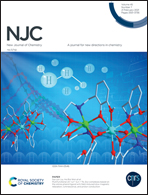Biologically relevant and energetically significant cooperative ternary (π–π)2/(π–π)1/(π–π)2 assemblies and fascinating discrete (H2O)21 clusters in isostructural 2,5-pyridine dicarboxylato Co(ii) and Zn(ii) phenanthroline compounds: antiproliferative evaluation and theoretical studies†
Abstract
Two new isostructural coordination compounds of cobalt(II) and zinc(II) involving 1,10-phenanthroline and 2,5-pyridine dicarboxylate, viz., [Co(2,5-PDC)(phen)2]·9H2O (1) and [Zn(2,5-PDC)(phen)2]·9H2O (2) (in which, PDC = pyridine dicarboxylate, phen = 1,10-phenanthroline) have been synthesized and characterised using FT-IR, electronic spectroscopy, thermal analysis, elemental analysis and single crystal X-ray diffraction techniques. Crystal structure analysis reveals that the neighboring monomeric units of 1 and 2 are self-assembled via π-stacking, C–H⋯π and C–H⋯O interactions. Fascinating and unusual discrete (H2O)21 clusters in 2 stabilize the network architecture. The self-assembled enclathration of water clusters in the hexameric supramolecular host cavity of 1 provides additional reinforcement to the crystal structure. The strength of the biologically relevant cooperative π-stacking interactions for 1 and 2 has been investigated using DFT calculations and analyzed using an NCI plot index. Remarkably, the (π–π)1 binding modes in the ternary π-stacked assemblies are energetically more significant than the (π–π)2 mode due to the contribution of the two symmetrically related C–H⋯O interactions. The large and almost identical dipole moments of the compounds nullify the influence of the metal centers on the strength of the cooperative π-stacked assemblies, and this corroborates the strong binding energies. The compounds significantly induce concentration dependent cell cytotoxicity and apoptosis in DL cancer cells with negligible cytotoxicity in normal cells. The molecular docking study and pharmacophore features establish the structure activity relationship (SAR) of the compounds.



 Please wait while we load your content...
Please wait while we load your content...